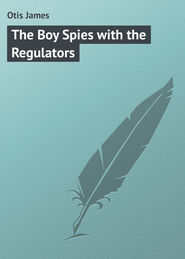По всем вопросам обращайтесь на: info@litportal.ru
(©) 2003-2025.
✖
The Boys of '98
Настройки чтения
Размер шрифта
Высота строк
Поля
“The three batteries at Manila had kept up a continuous report from the beginning of the engagement, which fire was not returned by this squadron.
“The first of these batteries was situated on the South Mole head, at the entrance to the Pasig River, the second on the south bastion of the walled city of Manila, and the third at Malate, about one-half mile farther south. At this point I sent a message to the governor-general, in effect that if the batteries did not cease firing the city would be shelled. This had the effect of silencing them.
“At 7.35 A. M. I ceased firing and withdrew the squadron for breakfast.
“At 11.16 A. M. returned to the attack. By this time the Spanish flag-ship and almost the entire Spanish fleet were in flames. At 12.30 P. M. the squadron ceased firing, the batteries being silenced, and the ships sunk, burned, and destroyed.
“At 12.40 P. M. the squadron returned and anchored off Manila, the Petrel being left behind to complete the destruction of the smaller gunboats, which were behind the point of Cavite. This duty was performed by Commander E. P. Wood in the most expeditious and complete manner possible.
“The Spanish lost the following vessels:
“Sunk: Reina Christina, Castilla, Don Antonio de Ulloa.
“Burned: Don Juan de Austria, Isla de Luzon, Isla de Cuba, General Lezo, Marques del Duero, El Correo, Velasco, and Isla de Mindanao, transport.
“Captured: Rapido and Hercules, tugs, and several small launches.
“I am unable to obtain complete accounts of the enemy’s killed and wounded, but believe their losses to be very heavy.
“The Reina Christina alone had 150 killed, including the captain, and ninety wounded.
“I am happy to report that the damage done to the squadron under my command was inconsiderable. There were none killed, and only seven men in the squadron were slightly wounded.
“Several of the vessels were struck, and two penetrated, but the damage was of the slightest, and the squadron is in as good condition now as before the battle.
“I beg to state to the department that I doubt if any commander-in-chief was ever served by more loyal, efficient, and gallant captains than those of the squadron now under my command.
“Capt. Frank Wildes, commanding the Boston, volunteered to remain in command of his vessel, although his relief arrived before leaving Hongkong. Assistant Surgeon Kindleberger of the Olympia and Gunner J. C. Evans of the Boston also volunteered to remain after orders detaching them had arrived.
“The conduct of my personal staff was excellent. Commander B. P. Lamberton, chief of staff, was a volunteer for that position, and gave me most efficient aid. Lieutenant Brumby, flag lieutenant, and Ensign W. P. Scott, aid, performed their duties as signal officers in a highly creditable manner.
“The Olympia being short of officers for the battery, Ensign H. H. Caldwell, flag secretary, volunteered for and was assigned to a subdivision of 5-inch battery. Mr. J. L. Stickney, formerly an officer in the United States navy, and now correspondent of the New York Herald, volunteered for duty as my aid, and did valuable service.
“I desire specially to mention the coolness of Lieut. C. G. Calkins, the navigator of the Olympia, who came under my personal observation, being on the bridge with me throughout the entire action, and giving the ranges to the guns with an accuracy that was proved by the excellence of the firing.
“On May 2d, the day following the engagement, the squadron again went to Cavite, where it remained.
“On the 3d, the military forces evacuated the Cavite arsenal, which was taken possession of by a landing party. On the same day the Raleigh and Baltimore secured the surrender of the batteries on Corregidor Island, paroling the garrison and destroying the guns.
“On the morning of May 4th the transport Manila, which had been aground in Baker Bay, was towed off and made a prize.”
List of the two fleets engaged at the battle of Manila Bay, together with the officers of the American fleet:
AMERICAN FLEET
The U. S. S. Olympia, protected cruiser, 5,870 tons, speed, 21.6 knots. Battery: four 8-inch rifles, ten 5-inch rapid-fire guns, fourteen 6-pounder rapid-fire guns, six 1-pounder rapid-fire cannon, four Gatlings, with six torpedo tubes, and eight automobile torpedoes.
The U. S. S. Baltimore, protected cruiser, 4,600 tons, speed, 20.09 knots. Battery: four 8-inch, six 6-inch rifles, four 6-pounder, two 3-pounder rapid-fire guns, two 1-pounder rapid-fire cannon, four 37-millimetre Hotchkiss cannon, and two Gatlings.
The U. S. S. Boston, protected cruiser, 3,189 tons, speed, 15.6 knots. Battery: two 8-inch, six 6-inch rifles, two 6-pounder, two 3-pounder rapid-fire guns, two 1-pounder rapid-fire cannon, two 47-millimetre Hotchkiss cannon, and two Gatlings.
The U. S. S. Raleigh, protected cruiser, 3,213 tons, speed, nineteen knots. Battery: one 6-inch, ten 5-inch rapid-fire guns, eight 6-pounder rapid-fire guns, four 1-pounder rapid-fire cannon, and two Gatlings.
The U. S. S. Concord, gunboat, 1,710 tons, speed, 16.8 knots. Battery: six 6-inch rifles, two 6-pounder, two 3-pounder rapid-fire guns, two 37-millimetre Hotchkiss cannon, and two Gatlings.
The U. S. S. Petrel, gunboat, 892 tons, speed, 11.7 knots. Battery: four 6-inch rifles, one 1-pounder rapid-fire gun, two 37-millimetre Hotchkiss cannon, and two Gatlings.
The U. S. S. McCulloch, revenue cutter, 1,500 tons, speed, fourteen knots. Battery: four 4-inch guns.
The Nanshan and Zafiro, supply ships.
SPANISH FLEET.
The Reina Maria Christina, 3,520 tons, speed, seventeen knots. Battery: six 6.2-inch hontoria guns, two 2.7-inch and three 2.2-inch rapid-fire rifles, six 1.4-inch, and two machine guns.
The Castilla, 3,342 tons. Battery: four 5.9-inch Krupp rifles, two 4.7-inch, two 3.3-inch, four 2.5-inch rapid-fire, and two machine guns.
The Velasco, 1,152 tons. Battery: three 5.9-inch Armstrong rifles, two 2.7-inch hontorias, and two machine guns.
The Don Antonio de Ulloa and Don Juan de Austria, each 1,130 tons, speed, fourteen knots. Battery: four 4.7-inch hontorias, three 3.2-inch rapid-fire, two 1.5-inch, and two machine guns.
The General Lezo, and El Correo, gun vessels, 524 tons, speed, 11.5 knots. The General Lezo had two hontoria rifles of 4.7-inch calibre, one 3.5-inch, two small rapid-fire, and one machine gun; the El Correo had three 4.7-inch guns, two small rapid-fire, and two machine guns.
The Marques del Duero, despatch-boat, 500 tons. Battery: one smooth bore, six 6.2-inch calibre, two 4.7-inch and one machine gun.
The Isla de Cuba and the Isla de Luzon were both small gunboats, 1,030 tons. Battery: four 4.7-inch hontorias, two small guns, and two machine guns.
The Isla de Mindanao, auxiliary cruiser, 4,195 tons, speed, 13.5 knots.
Two torpedo-boats and two transports.
Officers of the U. S. Asiatic Squadron: Acting Rear Admiral George Dewey, commander-in-chief; Commander B. P. Lamberton, chief of staff; Lieut. T. M. Brumby, flag lieutenant; Ensign H. H. Caldwell, secretary.
U. S. S. Olympia, flag-ship: Captain, Charles V. Gridley; Lieutenant-Commander, S. C. Paine; Lieutenants, C. G. Calkins, V. S. Nelson, G. S. Morgan, W. C. Miller, S. M. S. Strite; Ensigns, M. M. Taylor, F. B. Upham, W. P. Scott, A. G. Kavagnah; Medical Inspector, A. S. Price; Passed Assistant Surgeon, J. E. Page; Assistant Surgeon, C. P. Kindleberger; Pay Inspector, D. A. Smith; Chief Engineer, J. Entwistle; Assistant Engineers, E. H. Delaney, J. F. Marshall, Jr.; Chaplain, J. B. Frasier; Captain of Marines, W. P. Biddle; Gunner, L. J. G. Kuhlwein; Carpenter, W. McDonald; Acting Boatswain, E. J. Norcott.
U. S. S. Raleigh: Captain, J. B. Coghlan; Lieutenant-Commander, F. Singer; Lieutenants, W. Winder, B. Tappan, H. Rodman, C. B. Morgan; Ensigns, F. L. Chidwick, P. Babbit; Surgeon, E. H. Marsteller; Assistant Surgeon, D. N. Carpenter; Passed Assistant Paymaster, S. R. Heap; Chief Engineer, F. H. Bailey; Passed Assistant Engineer, A. S. Halstead; Assistant Engineer, J. R. Brady; First Lieutenant of Marines, T. C. Treadwell; Acting Gunner, G. D. Johnstone; Acting Carpenter, T. E. Kiley.
U. S. S. Boston: Captain, F. Wildes; Lieutenant-Commander, J. A. Norris; Lieutenants, J. Gibson, W. L. Howard; Ensigns, S. S. Robinson, L. H. Everhart, J. S. Doddridge; Surgeon, M. H. Crawford; Assistant Surgeon, R. S. Balkeman; Paymaster, J. R. Martin; Chief Engineer, G. B. Ransom; Assistant Engineer, L. K. James; First Lieutenant of Marines, R. McM. Dutton; Gunner, J. C. Evans; Carpenter, I. H. Hilton.
U. S. S. Baltimore: Captain, N. M. Dyer; Lieutenant-Commander, G. Blocklinger; Lieutenants, W. Braunersreuther, A. G. Winterhalter, F. W. Kellogg, J. M. Ellicott, C. S. Stanworth; Ensigns, J. H. Hayward, M. D. McCormick; Naval Cadets, D. W. Wurtsburgh, I. Z. Wettenzoll, C. M. Tozer, T. A. Karney; Passed Assistant Surgeon, F. A. Heiseler; Assistant Surgeon, R. K. Smith; Pay Inspector, R. E. Bellows; Chief Engineer, A. Kirby; Assistant Engineers, H. B. Price, H. I. Cone; Naval Cadet, C. P. Burt; Chaplain, T. S. K. Freeman; First Lieutenant of Marines, D. Williams; Acting Boatswain, H. R. Brayton; Acting Gunner, L. J. Waller; Carpenter, O. Bath.
U. S. S. Concord: Commander, A. S. Walker; Lieutenant-Commander, G. P. Colvocoresses; Lieutenants, T. B. Howard, P. W. Horrigan; Ensigns, L. A. Kiser, W. C. Davidson, O. S. Knepper; Passed Assistant Surgeon, R. G. Broderick; Passed Assistant Paymaster, E. D. Ryan; Chief Engineer, Richard Inch; Passed Assistant Engineer, H. W. Jones; Assistant Engineer, E. H. Dunn.
U. S. S. Petrel: Commander, E. P. Wood; Lieutenants, E. M. Hughes, B. A. Fiske, A. N. Wood, C. P. Plunkett; Ensigns, G. L. Fermier, W. S. Montgomery; Passed Assistant Surgeon, C. D. Brownell; Assistant Paymaster, G. G. Seibles; Passed Assistant Engineer, R. T. Hall.
Revenue Cutter McCulloch: Captain, D. B. Hodgdon.
American loss: Two officers and six men wounded.
“The first of these batteries was situated on the South Mole head, at the entrance to the Pasig River, the second on the south bastion of the walled city of Manila, and the third at Malate, about one-half mile farther south. At this point I sent a message to the governor-general, in effect that if the batteries did not cease firing the city would be shelled. This had the effect of silencing them.
“At 7.35 A. M. I ceased firing and withdrew the squadron for breakfast.
“At 11.16 A. M. returned to the attack. By this time the Spanish flag-ship and almost the entire Spanish fleet were in flames. At 12.30 P. M. the squadron ceased firing, the batteries being silenced, and the ships sunk, burned, and destroyed.
“At 12.40 P. M. the squadron returned and anchored off Manila, the Petrel being left behind to complete the destruction of the smaller gunboats, which were behind the point of Cavite. This duty was performed by Commander E. P. Wood in the most expeditious and complete manner possible.
“The Spanish lost the following vessels:
“Sunk: Reina Christina, Castilla, Don Antonio de Ulloa.
“Burned: Don Juan de Austria, Isla de Luzon, Isla de Cuba, General Lezo, Marques del Duero, El Correo, Velasco, and Isla de Mindanao, transport.
“Captured: Rapido and Hercules, tugs, and several small launches.
“I am unable to obtain complete accounts of the enemy’s killed and wounded, but believe their losses to be very heavy.
“The Reina Christina alone had 150 killed, including the captain, and ninety wounded.
“I am happy to report that the damage done to the squadron under my command was inconsiderable. There were none killed, and only seven men in the squadron were slightly wounded.
“Several of the vessels were struck, and two penetrated, but the damage was of the slightest, and the squadron is in as good condition now as before the battle.
“I beg to state to the department that I doubt if any commander-in-chief was ever served by more loyal, efficient, and gallant captains than those of the squadron now under my command.
“Capt. Frank Wildes, commanding the Boston, volunteered to remain in command of his vessel, although his relief arrived before leaving Hongkong. Assistant Surgeon Kindleberger of the Olympia and Gunner J. C. Evans of the Boston also volunteered to remain after orders detaching them had arrived.
“The conduct of my personal staff was excellent. Commander B. P. Lamberton, chief of staff, was a volunteer for that position, and gave me most efficient aid. Lieutenant Brumby, flag lieutenant, and Ensign W. P. Scott, aid, performed their duties as signal officers in a highly creditable manner.
“The Olympia being short of officers for the battery, Ensign H. H. Caldwell, flag secretary, volunteered for and was assigned to a subdivision of 5-inch battery. Mr. J. L. Stickney, formerly an officer in the United States navy, and now correspondent of the New York Herald, volunteered for duty as my aid, and did valuable service.
“I desire specially to mention the coolness of Lieut. C. G. Calkins, the navigator of the Olympia, who came under my personal observation, being on the bridge with me throughout the entire action, and giving the ranges to the guns with an accuracy that was proved by the excellence of the firing.
“On May 2d, the day following the engagement, the squadron again went to Cavite, where it remained.
“On the 3d, the military forces evacuated the Cavite arsenal, which was taken possession of by a landing party. On the same day the Raleigh and Baltimore secured the surrender of the batteries on Corregidor Island, paroling the garrison and destroying the guns.
“On the morning of May 4th the transport Manila, which had been aground in Baker Bay, was towed off and made a prize.”
List of the two fleets engaged at the battle of Manila Bay, together with the officers of the American fleet:
AMERICAN FLEET
The U. S. S. Olympia, protected cruiser, 5,870 tons, speed, 21.6 knots. Battery: four 8-inch rifles, ten 5-inch rapid-fire guns, fourteen 6-pounder rapid-fire guns, six 1-pounder rapid-fire cannon, four Gatlings, with six torpedo tubes, and eight automobile torpedoes.
The U. S. S. Baltimore, protected cruiser, 4,600 tons, speed, 20.09 knots. Battery: four 8-inch, six 6-inch rifles, four 6-pounder, two 3-pounder rapid-fire guns, two 1-pounder rapid-fire cannon, four 37-millimetre Hotchkiss cannon, and two Gatlings.
The U. S. S. Boston, protected cruiser, 3,189 tons, speed, 15.6 knots. Battery: two 8-inch, six 6-inch rifles, two 6-pounder, two 3-pounder rapid-fire guns, two 1-pounder rapid-fire cannon, two 47-millimetre Hotchkiss cannon, and two Gatlings.
The U. S. S. Raleigh, protected cruiser, 3,213 tons, speed, nineteen knots. Battery: one 6-inch, ten 5-inch rapid-fire guns, eight 6-pounder rapid-fire guns, four 1-pounder rapid-fire cannon, and two Gatlings.
The U. S. S. Concord, gunboat, 1,710 tons, speed, 16.8 knots. Battery: six 6-inch rifles, two 6-pounder, two 3-pounder rapid-fire guns, two 37-millimetre Hotchkiss cannon, and two Gatlings.
The U. S. S. Petrel, gunboat, 892 tons, speed, 11.7 knots. Battery: four 6-inch rifles, one 1-pounder rapid-fire gun, two 37-millimetre Hotchkiss cannon, and two Gatlings.
The U. S. S. McCulloch, revenue cutter, 1,500 tons, speed, fourteen knots. Battery: four 4-inch guns.
The Nanshan and Zafiro, supply ships.
SPANISH FLEET.
The Reina Maria Christina, 3,520 tons, speed, seventeen knots. Battery: six 6.2-inch hontoria guns, two 2.7-inch and three 2.2-inch rapid-fire rifles, six 1.4-inch, and two machine guns.
The Castilla, 3,342 tons. Battery: four 5.9-inch Krupp rifles, two 4.7-inch, two 3.3-inch, four 2.5-inch rapid-fire, and two machine guns.
The Velasco, 1,152 tons. Battery: three 5.9-inch Armstrong rifles, two 2.7-inch hontorias, and two machine guns.
The Don Antonio de Ulloa and Don Juan de Austria, each 1,130 tons, speed, fourteen knots. Battery: four 4.7-inch hontorias, three 3.2-inch rapid-fire, two 1.5-inch, and two machine guns.
The General Lezo, and El Correo, gun vessels, 524 tons, speed, 11.5 knots. The General Lezo had two hontoria rifles of 4.7-inch calibre, one 3.5-inch, two small rapid-fire, and one machine gun; the El Correo had three 4.7-inch guns, two small rapid-fire, and two machine guns.
The Marques del Duero, despatch-boat, 500 tons. Battery: one smooth bore, six 6.2-inch calibre, two 4.7-inch and one machine gun.
The Isla de Cuba and the Isla de Luzon were both small gunboats, 1,030 tons. Battery: four 4.7-inch hontorias, two small guns, and two machine guns.
The Isla de Mindanao, auxiliary cruiser, 4,195 tons, speed, 13.5 knots.
Two torpedo-boats and two transports.
Officers of the U. S. Asiatic Squadron: Acting Rear Admiral George Dewey, commander-in-chief; Commander B. P. Lamberton, chief of staff; Lieut. T. M. Brumby, flag lieutenant; Ensign H. H. Caldwell, secretary.
U. S. S. Olympia, flag-ship: Captain, Charles V. Gridley; Lieutenant-Commander, S. C. Paine; Lieutenants, C. G. Calkins, V. S. Nelson, G. S. Morgan, W. C. Miller, S. M. S. Strite; Ensigns, M. M. Taylor, F. B. Upham, W. P. Scott, A. G. Kavagnah; Medical Inspector, A. S. Price; Passed Assistant Surgeon, J. E. Page; Assistant Surgeon, C. P. Kindleberger; Pay Inspector, D. A. Smith; Chief Engineer, J. Entwistle; Assistant Engineers, E. H. Delaney, J. F. Marshall, Jr.; Chaplain, J. B. Frasier; Captain of Marines, W. P. Biddle; Gunner, L. J. G. Kuhlwein; Carpenter, W. McDonald; Acting Boatswain, E. J. Norcott.
U. S. S. Raleigh: Captain, J. B. Coghlan; Lieutenant-Commander, F. Singer; Lieutenants, W. Winder, B. Tappan, H. Rodman, C. B. Morgan; Ensigns, F. L. Chidwick, P. Babbit; Surgeon, E. H. Marsteller; Assistant Surgeon, D. N. Carpenter; Passed Assistant Paymaster, S. R. Heap; Chief Engineer, F. H. Bailey; Passed Assistant Engineer, A. S. Halstead; Assistant Engineer, J. R. Brady; First Lieutenant of Marines, T. C. Treadwell; Acting Gunner, G. D. Johnstone; Acting Carpenter, T. E. Kiley.
U. S. S. Boston: Captain, F. Wildes; Lieutenant-Commander, J. A. Norris; Lieutenants, J. Gibson, W. L. Howard; Ensigns, S. S. Robinson, L. H. Everhart, J. S. Doddridge; Surgeon, M. H. Crawford; Assistant Surgeon, R. S. Balkeman; Paymaster, J. R. Martin; Chief Engineer, G. B. Ransom; Assistant Engineer, L. K. James; First Lieutenant of Marines, R. McM. Dutton; Gunner, J. C. Evans; Carpenter, I. H. Hilton.
U. S. S. Baltimore: Captain, N. M. Dyer; Lieutenant-Commander, G. Blocklinger; Lieutenants, W. Braunersreuther, A. G. Winterhalter, F. W. Kellogg, J. M. Ellicott, C. S. Stanworth; Ensigns, J. H. Hayward, M. D. McCormick; Naval Cadets, D. W. Wurtsburgh, I. Z. Wettenzoll, C. M. Tozer, T. A. Karney; Passed Assistant Surgeon, F. A. Heiseler; Assistant Surgeon, R. K. Smith; Pay Inspector, R. E. Bellows; Chief Engineer, A. Kirby; Assistant Engineers, H. B. Price, H. I. Cone; Naval Cadet, C. P. Burt; Chaplain, T. S. K. Freeman; First Lieutenant of Marines, D. Williams; Acting Boatswain, H. R. Brayton; Acting Gunner, L. J. Waller; Carpenter, O. Bath.
U. S. S. Concord: Commander, A. S. Walker; Lieutenant-Commander, G. P. Colvocoresses; Lieutenants, T. B. Howard, P. W. Horrigan; Ensigns, L. A. Kiser, W. C. Davidson, O. S. Knepper; Passed Assistant Surgeon, R. G. Broderick; Passed Assistant Paymaster, E. D. Ryan; Chief Engineer, Richard Inch; Passed Assistant Engineer, H. W. Jones; Assistant Engineer, E. H. Dunn.
U. S. S. Petrel: Commander, E. P. Wood; Lieutenants, E. M. Hughes, B. A. Fiske, A. N. Wood, C. P. Plunkett; Ensigns, G. L. Fermier, W. S. Montgomery; Passed Assistant Surgeon, C. D. Brownell; Assistant Paymaster, G. G. Seibles; Passed Assistant Engineer, R. T. Hall.
Revenue Cutter McCulloch: Captain, D. B. Hodgdon.
American loss: Two officers and six men wounded.











